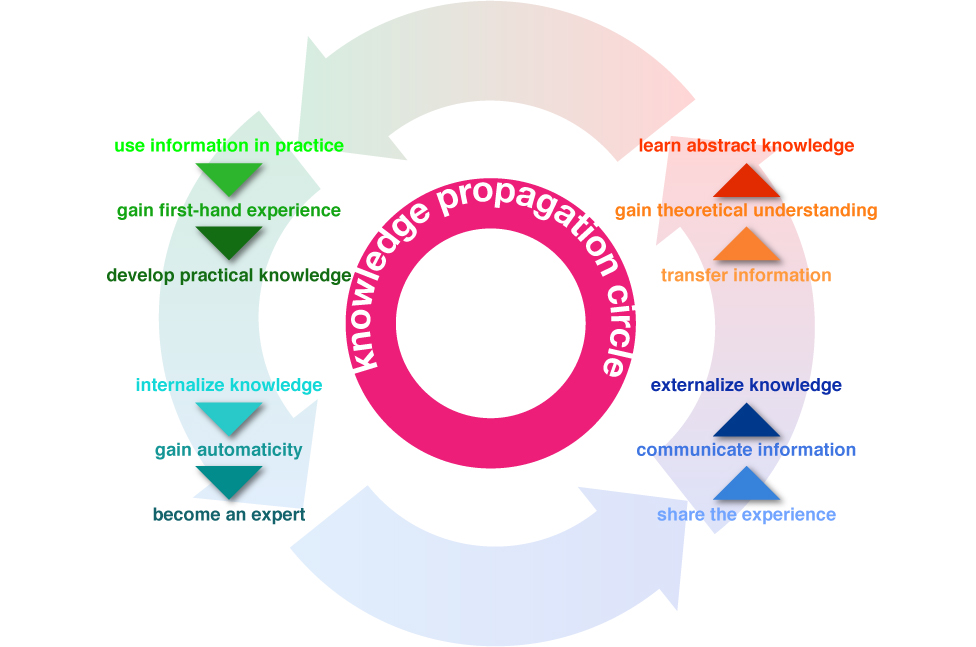Not much to add here — how many other cool video games are there for visually disabled? Using tactile clues instead of visual signals is a nice interaction design solution. Well done!
Cultural Differences
Conceptual Design, Cultural Differences, Ethnographic & User Data, Interaction Design, Interface Design, Pipsqueak Articles, Product Design Strategy, Reference
End-User Development (EUD) Educational Preview
by Olga Werby •
This is an interesting collection of videos and background materials on End-User Development — situations when end users design and develop software for their own use. If you’re old enough, you would remember BASIC and HyperCard — tools that let anyone develop simple games and applications. A great example is “Spelunking” game totally developed in HyperCard (these guys when on to develop “Myst”!). I’ve made a few games like this myself. And of course FileMaker is another system that allows application development by the end users — we have one for time tracking. There have been many many others, and unfortunately, many of them are now gone. The discussion on what happens when end users develop for themselves is fascinating. Most times, these users are experts in their own fields and are not software developers (some have no and some have little formal training). Thus there are cultural differences between “real” programmers and end users that take up programming to achieve their own goals, often because they can’t find what they need out in the world. These end-user designed products have strengths and they also have many weakness. In particular, these products are tightly focused on the needs of those…
Conceptual Design, Cultural Bias, Cultural Differences, Ethnographic & User Data, Pipsqueak Articles, Users
Rewired Brain
by Olga Werby •

Our kids have grown up in the world where computers were always present and always on. They can’t conceive of a time when they can be cut off from the Internet (vacations in the Internet-dead zones are definite no go). Our kids are the generation of fully-connected always-on Internet users. What about the kids that are born right now? Not the Millennials, as they are being called, but these babies born in the age of the iPad? The iTouch Babies? How are their brains being rewired from the experience of having the iPad as their first toy? Check out this video of a baby girl growing in the iTouch World.
Anchoring Errors, Cognitive Blindness, Conceptual Design, Cultural Bias, Cultural Differences, Ethnographic & User Data, Mental Model Traps, Mirroring Errors, Pipsqueak Articles, Product Design Strategy
The Cultural Context for Product Design
by Olga Werby •

Nothing exists in isolation. Design divorced from the context in which the product is used is of little value to its audience. Cognitively, this makes sense—most designers agree that they have to consider the environment, culture, and situation as part of the process of developing a new product (or redesigning an old one). But practically, context and culture get little play in design meetings. This post is aimed at relieving some of designers’ mirroring errors—helping see alternate ways their products might be used in the real world. Enjoy! Cultural Difference in Car Use: livestock Cultural Difference in Car Use: large loads Cultural Difference in Bike Use: large loads Notice the little bike on the left… Cultural Difference: people movers
Background Knowledge, Background Knowledge Errors, Conceptual Design, Cultural Bias, Cultural Differences, Pipsqueak Articles, Product Design Strategy
Cultural and Subject Matter Knowledge
by Olga Werby •

What is that?! Is that what I think it is? These toys were part of a window display in a little store in the center of Rome. I don’t believe a lot of kids play with Nazi toy soldiers…in Italy, today. But if WWII turned out differently, these might have been the coveted toys, not just for a limited set of adult collectors, but for average, everyday kids…who happened to be living in an alternate reality. So this brings me to the main point of this post: products have to have cultural relevance, and this requires designers to have a good grasp on social background knowledge and on the subject matter within which they are working. Consider this little street sign in Rome as another example of cultural and subject matter relevancy: If you click on the image, you can get a larger version—yes, it is a crucifix with Jesus icon. Here in San Francisco, this sign wouldn’t work. But in Rome, it makes perfect sense. It’s culturally relevant and conveys information to the local population. Both of these examples show that it’s not just cultural knowledge that’s important. Without knowing the meaning of a crucifix or being able to…
Background Knowledge, Background Knowledge Errors, Causal Net Problems, Cognitive Blindness, Conceptual Design, Cultural Bias, Cultural Differences, Ethnographic & User Data, Featured, Group Decision Errors, Mental Model Traps, Mirroring Errors, Pipsqueak Articles, Product Design Strategy
Community of Practice and Knowledge Propagation Circle
by Olga Werby •

This summer my family and I travelled to Rome. While the temperatures didn’t reach the usual astronomic heights, it was rather warm. But we, and other visitors, didn’t have to worry about thirst. Rome has the best network of public drinking fountains that I have ever seen. Every few blocks, there’s a beautifully-designed basin with a spigot of continuously running water (I know, being from California, the never-ending stream made us very uncomfortable, too). There are two bits of information that have to be passed on to the first-time visitors of Rome: the water is potable—safe to drink, and how to use the fountain—there’s a bit of a trick to them. Above is my son demonstrating a little secret interaction. There’s a small hole on the top of the pipe that can serve as drinking fountain if the main hole at the end is plugged up (with a finger). While we learned about the great drinking water in Rome from many traveling guides (books, online sites, etc.), we obviously didn’t know about the trick until we watched a pro do it. Knowledge Propagation Circle Information propagates through communities. When we first encounter a novel bit of data, it tends to…
Background Knowledge, Conceptual Design, Cultural Bias, Cultural Differences, Ethnographic & User Data, Pipsqueak Articles, Product Design Strategy
Cultural Differences from the 4th Dimension: Time
by Olga Werby •

Some cultural differences are brought to you by geographic distances, but some derive their wonderful exotic qualities from temporal separation. The ads below are all American…just from a different America—America of yesteryore. Role of Women What wives are for? Make her happy this Christmas—make it a hoover! Blow smoke in her face, she’ll love it! Go ahead and cry for it… Housework makes wives cute! Housework makes wives healthy. Healthy Kids Beer for mommies and babies… Give that baby a cola! Give your children the benefit of TV. Healthy You! Give cocaine a chance… Doctors prefer Camels. For a slimmer, flatter, more sinuous you, go with tape worms!
